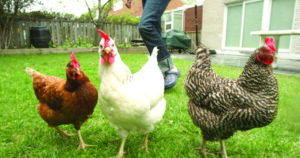By Dr. Beth Leermakers
As I was walking my dogs early this morning, I heard a chicken crowing. Yes, in my Dallas neighborhood. In Dallas, it is illegal to keep a rooster, but you can keep hens in your backyard.
I decided to find out what’s involved in keeping chickens as pets — and egg producers. Given the sky-high cost of eggs these days, perhaps it would be worth investing in a few hens.

Photo courtesy of Blogto.com
Does it make financial sense to keep chickens? Here’s what you’ll need to keep chickens — and what it will cost.
The birds. Different breeds of chickens have different appearances, temperaments and egg-laying abilities. Depending on the breed, eggs may be white, brown, blue, green or even pink! How fun is that? Chickens are social animals who like to hang out in groups, so your flock should include at least three hens. For most backyard flocks, five or six chickens is an ideal size. You can purchase chicks or older birds through hatcheries online, private individuals or local farm supply stores.
Chickens are typically sold at four ages:
• Day-old chicks ($2-$5 per chick, depending on the breed, but you’ll spend more on feed until the hens are ready to lay eggs)
• Pullets (6-10 weeks old; usually cost about $12-$20 more than a day-old chick of the same breed)
• Point-of-lay birds (just about ready to start laying eggs; 16-22 weeks, depending on the breed; prices vary, but they usually only cost a few dollars more than pullets)
• Adult hens/layers (These aren’t usually sold by hatcheries, so you would need to buy them from someone privately.)
Food. Because they lack essential nutrients, homemade diets are not recommended for chickens. Commercially available, high quality feed (pellets and crumbles) is critical for successful egg-laying and should make up most of the flock’s diet.
Hens’ nutritional needs change as they grow and begin laying eggs, so it’s important to switch to the appropriate, age-specific food. “Starter” feed is appropriate for chicks under six weeks of age, “grower” feed is for chicks between 6-16 weeks of age, and “layer” feed is for egg-laying hens over 16 weeks. Layer hen pellets cost about $20-$25 for a 50 pound bag (at Tractor Supply Company).
How long will that 50 lb. bag last? In general, mature chickens eat about 1.5 pounds of feed per week. A flock of five chickens will go through a 50 pound bag in about six weeks.
Housing. Chickens need a shelter (a coop), with good ventilation, to protect them from predators and the elements. A modified shed makes a good coop, or you can purchase a coop (about $200 to $600 or more for penthouse models) or build your own. Coops should be slightly elevated off the ground to prevent flooding and have:
• Windows on each side
• Enough nest boxes (with bedding) to allow several chickens to nest simultaneously
• One perch for each bird
• Outlets for lighting
• Fans
• Air inlets or ventilation holes on the roof
• A concrete floor treated with a pet-safe waterproof coating that allows for easy cleaning and drainage.
Will You Save Money by Raising Chickens?
According to The Fewell Homestead, a simple living website, you’ll need about $500-$1500 the first month to get everything (including the coop) up and running. According to The Hen House Collection, the maximum cost to raise five hens in your backyard, kept for five years, is about $70 per month. That includes the birds, coop, feed, bedding, feeders/waterers and medicine. Yet another source stated that it cost $1900 to raise four chickens for the first year, then $35/month ($420/year) after that.
How many eggs will you get? That depends on the hen’s breed and age. Most hens start laying eggs daily between 18-24 weeks of age and lay the most eggs between 1-2 years of age, after which egg laying wanes.
Collecting eggs as they are laid encourages further laying. Chickens lay fewer eggs in the winter, when daylight is shorter.
Hens need at least 12 to 14 hours of light each day to continue laying eggs. A regular light bulb is sufficient to supply this light. At 18 months of age, chickens go through a gradual molt of feathers over 2-4 months during which time they lay few to no eggs. After that, molting occurs annually.
A good laying hen can produce 200 to 250 eggs each year. With eggs at almost $5 per dozen, you could “save” about $420 a year if you have five hens laying 200 eggs per year. But when you factor in the cost of keeping them ($45-$70 per month), it probably doesn’t make financial sense. However, if you would enjoy the companionship of having pet chickens, it may be worth it. If nothing else, think of the stories you’ll be able to tell!
